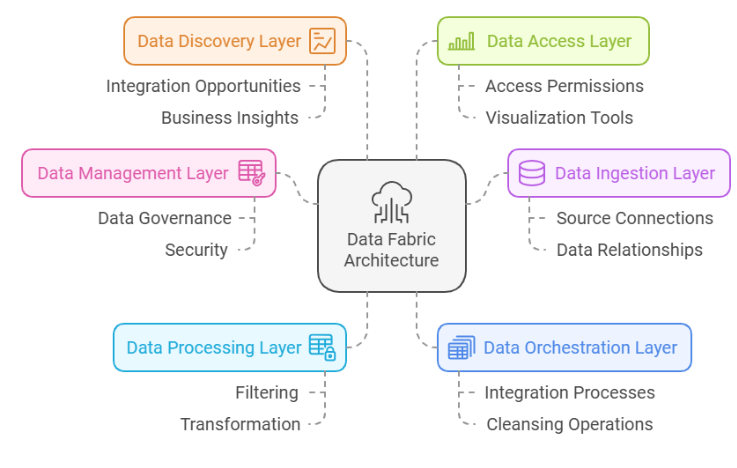Abstract
In the era of big data, organizations face significant challenges in managing diverse and voluminous data from multiple sources. Data fabric emerges as a solution, providing a unified architectural framework that simplifies data management and enhances decision-making. This document explores the concept of data fabric, its architecture, and how it enables organizations to achieve unified insights by overcoming traditional data silos.
Problem Statement: The Need for Data Fabric
In today’s world, data is often referred to as the new oil, serving as the fuel that energizes every organization. It enables companies to make informed decisions and predict their future trajectories. However, the vast amount of data generated daily from various sources and in different formats presents significant management challenges. This is where data fabric enters the picture.
Defining Data Fabric
Data fabric is an intelligent and unified architectural framework designed to simplify data management by seamlessly integrating, accessing, and governing data across distributed environments. It connects diverse structured and unstructured data sources, pipelines, and cloud ecosystems in real-time, empowering organizations to manage complexities and make data-driven decisions efficiently.
Why Data Fabric?
Organizations face several challenges when managing and utilizing data through traditional means, including:
- Data Variety and Volume: The increasing volume and variety of data make it difficult to manage and analyze.
- Data Gravity: As data grows in size, moving it becomes more difficult and expensive.
- Isolated Data Sources (Data Silos): Data stored in isolated systems hinders sharing and integration.
- Need for Real-Time Insights: Businesses require quick access to data for informed decision-making.
Data fabric helps tackle these challenges.
Data Fabric Architecture
Data fabrics pull together data from different sources, such as data lakes, data warehouses, and SQL databases, via APIs and data services, providing a comprehensive view of business performance. The architecture varies based on specific needs but generally includes the following key components:

Example: Hospital Data Management
Consider a hospital with patient data scattered across various systems, including personal details, health records, lab results, and data from wearable devices. The data fabric architecture would be tailored to unify and manage this scattered information effectively.
Achieving Unified Insights with Data Fabric
A data fabric enables unified insights by creating a seamless and integrated data environment that overcomes the limitations of traditional data silos. Here’s how it works:
1. Connecting Different Data Sources:
- Data fabrics act as a bridge between various data sources, including:
- Data Lakes: Store vast amounts of raw data in various formats.
- Data Warehouses: Store structured, processed data for reporting and analysis.
- SQL and NoSQL Databases: Store operational data for applications.
- Cloud Storage: Stores data in cloud environments like AWS S3 or Azure Blob Storage.
- Applications and APIs: Provide access to data through APIs and application interfaces.
- By connecting these sources, the data fabric breaks down data silos and makes all data accessible from a central point.
2. Cleaning and Transforming the Data:
- Data fabrics employ data processing and orchestration layers to:
- Cleanse Data: Remove errors, inconsistencies, and duplicates.
- Transform Data: Convert data into a consistent format and structure.
- This ensures that data from different sources can be easily combined and analyzed.
3. Enabling Data Discovery and Exploration:
- Data fabrics provide tools and capabilities for:
- Data Cataloging: Creating a searchable inventory of all available data assets.
- Metadata Management: Defining and managing metadata to understand data context and meaning.
- Data Lineage Tracking: Tracing the origin and transformations of data.
- This empowers users to easily discover relevant data and understand its context.
4. Facilitating Data Integration and Analysis:
- Data fabrics enable seamless data integration by:
- Automating Data Pipelines: Creating automated workflows for data ingestion, processing, and delivery.
- Providing Data APIs: Offering standardized interfaces for accessing and querying data.
- This allows users to combine data from different sources and perform comprehensive analysis.
5. Supporting Data Visualization and Reporting:
- Data fabrics integrate with data visualization and reporting tools to:
- Create Dashboards: Provide interactive visualizations of key metrics and trends.
- Generate Reports: Create detailed reports for business analysis and decision-making.
- This makes it easier for users to understand and communicate insights derived from the data.
Summary
A data fabric enables unified insights by:
- Breaking down data silos: Connecting all data sources.
- Cleaning and transforming the data: Ensuring data consistency and quality.
- Enabling data discovery and exploration: Making it easy to find and understand data.
- Facilitating data integration and analysis: Enabling comprehensive analysis across all data.
- Supporting data visualization and reporting: Making insights accessible and actionable.
With Edgematics, by leveraging these capabilities, organizations can effectively utilize data fabrics to gain deeper insights, uncover hidden patterns, and drive better business outcomes.
Book a Discovery Call now!
Author
Ankit Hiremath, Sr. Data Engineer, Edgematics


